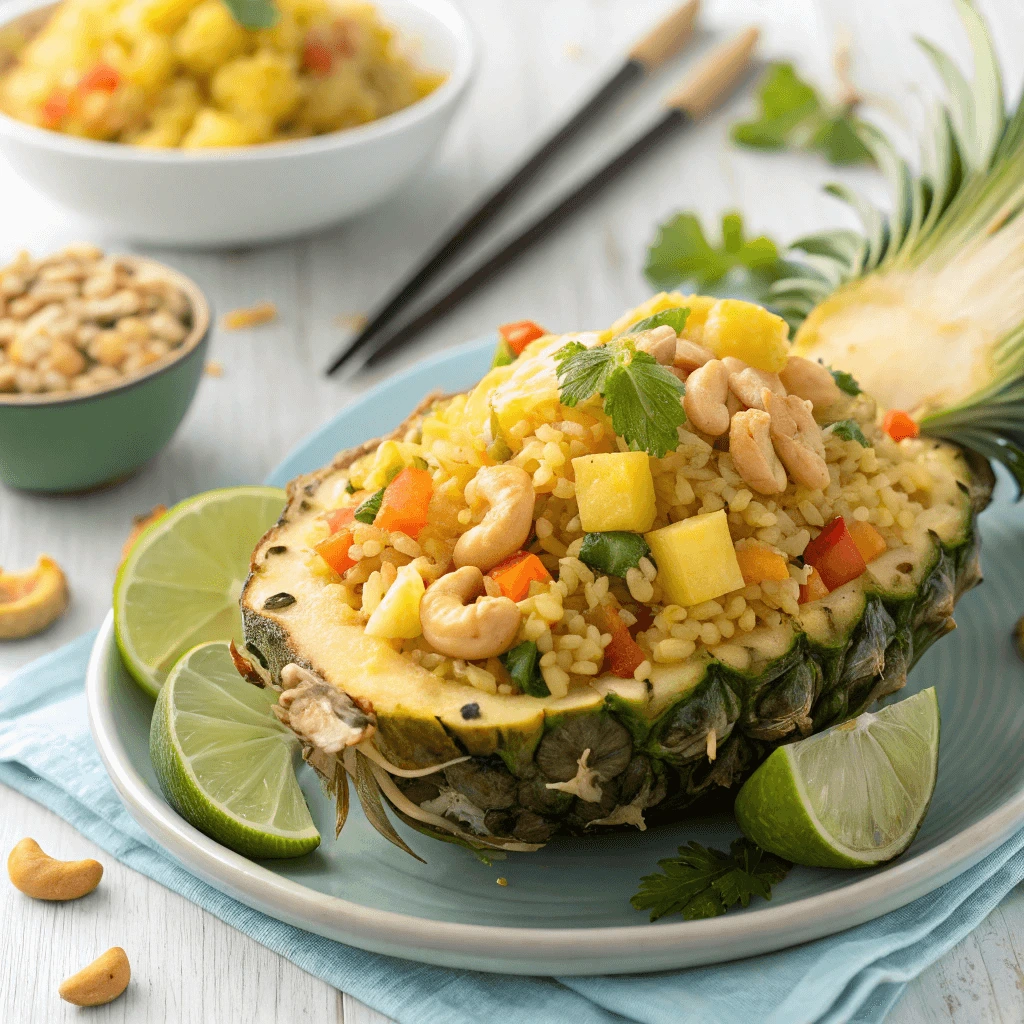Leftover rice often ends up forgotten in the fridge, but it doesn’t have to be that way! With these 5 simple rice hack recipes, you can transform your leftovers into exciting and flavorful dishes that will elevate your meals. Not only are these recipes quick and budget-friendly, but they also make meal prep a breeze. Whether you’re craving a savory fried rice or a sweet dessert, these rice hacks will surely change your cooking game. Ready to discover how? Let’s dive in and get creative with rice!
Quick and Easy 5-Simple-Rice-Hack-Recipes for Busy Nights
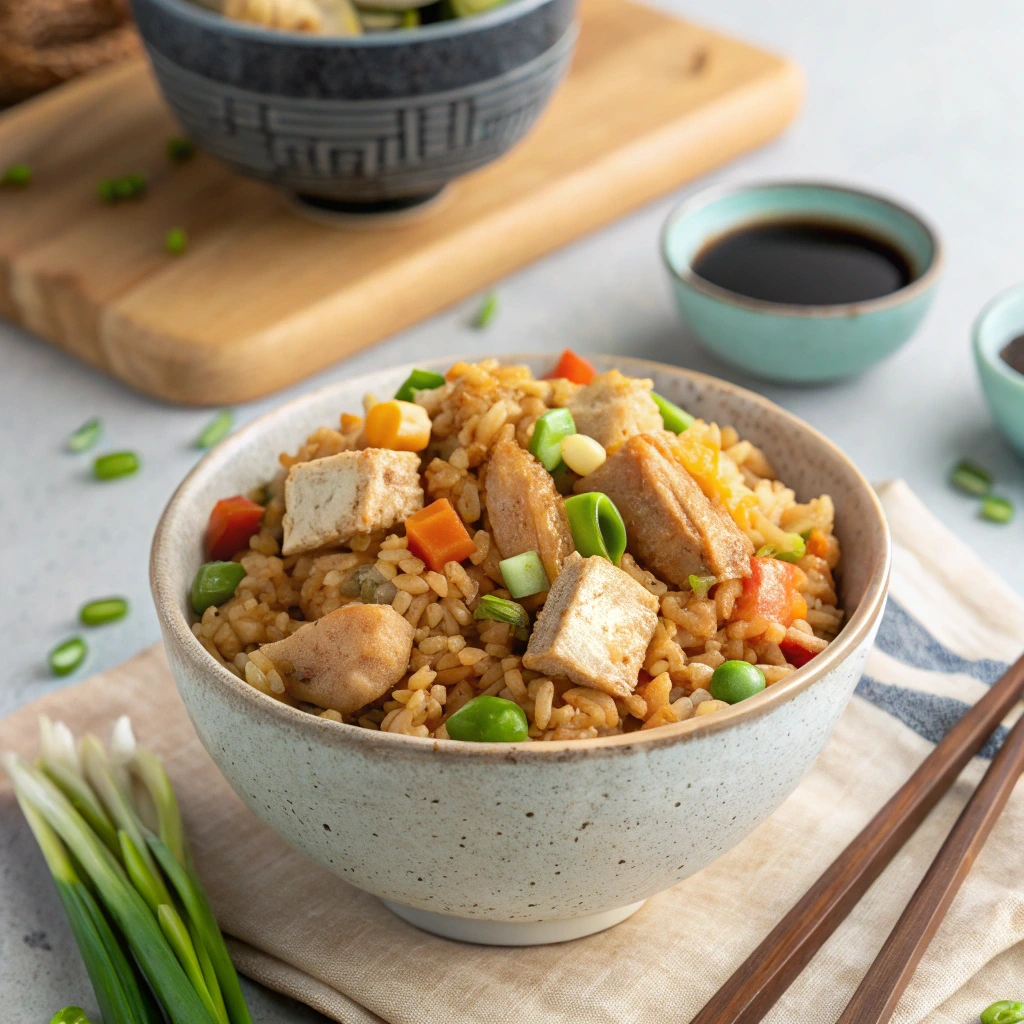
5-Minute Garlic Fried Rice – A Simple Rice Hack for Busy Days
Garlic fried rice is a timeless favorite, but when you need something fast, flavorful, and filling, this 5-minute version with veggies is a game-changer. Perfect for busy weeknights, this recipe helps you transform leftover rice into a satisfying meal with minimal effort.
Ingredients You’ll Need:
- 2 cups of day-old cooked rice (preferably jasmine or basmati)
- 2 tablespoons oil (canola, sesame, or olive oil work well)
- 4 garlic cloves, minced
- 1 cup of mixed vegetables (like carrots, peas, bell peppers, or corn)
- 2 tablespoons soy sauce or tamari
- 1 teaspoon sesame oil (optional, for flavor)
- Chopped scallions or parsley for garnish
Quick and Easy Cooking Steps:
- Heat the oil in a large skillet or wok over medium-high heat. Add the minced garlic and stir until golden and fragrant—this is where the flavor begins.
- Toss in the veggies and stir-fry for 2–3 minutes until tender yet crisp. Frozen veggies work great here and require no prep.
- Add the leftover rice and break it up with your spatula or spoon. Stir continuously to coat the rice evenly in the garlic and veggie mixture.
- Splash in the soy sauce and sesame oil, mixing thoroughly to bring everything together.
- Top it off with scallions, herbs, or even a sprinkle of chili flakes if you like some heat.
Why This Hack Works:
Using day-old rice prevents clumping and allows for that delicious crispy texture. The garlic brings depth, while the vegetables add color, crunch, and nutrition. It’s fast, customizable, and ideal for cleaning out your fridge.
One-Pot Spicy Kimchi Fried Rice: A Flavorful Rice Hack Recipe
Turn your leftover rice into a bold, flavor-packed meal with this fiery, tangy Korean-inspired recipe. Spicy kimchi fried rice isn’t just a comfort food staple—it’s a genius way to transform leftover rice into a one-pot wonder bursting with texture and umami.
Ingredients That Pack a Punch:
- 2 cups of day-old rice (short-grain or jasmine preferred)
- ¾ cup of chopped kimchi (plus 1–2 tbsp kimchi juice for extra flavor)
- 1 small onion, diced
- 2 garlic cloves, minced
- 1 tablespoon gochujang (Korean red chili paste)
- 2 teaspoons soy sauce
- 2 eggs (optional, for topping)
- 1 tablespoon sesame oil
- Green onions and toasted sesame seeds for garnish
Step-by-Step Cooking Instructions:
- Sauté aromatics: In a large skillet or pot, heat a tablespoon of oil. Add the onions and garlic, cooking until soft and fragrant.
- Add kimchi and gochujang: Stir in chopped kimchi and gochujang paste. Let them cook for 2–3 minutes to deepen the flavor.
- Toss in the rice: Add your day-old rice and break it apart. Stir to coat the grains evenly with the spicy, savory mixture.
- Season and stir-fry: Add soy sauce and a splash of kimchi juice. Stir-fry everything together until the rice is heated through and slightly crispy at the edges.
- Top with eggs (optional): Fry or scramble eggs separately and place them on top of your rice for added protein and richness.
Why This Recipe Works:
Kimchi’s fermented tang cuts through the richness of the rice, while gochujang adds depth and a slow-building heat. The one-pot method simplifies cleanup, and it’s easy to customize with tofu, mushrooms, or shredded chicken.
Mediterranean Lemon Herb Rice Bowl: A Refreshing Rice Hack Recipe
Give your leftover rice a bright and refreshing upgrade with this Mediterranean-inspired rice bowl. Packed with zesty flavors, fresh herbs, and nutrient-dense toppings, this dish proves that you can transform leftover rice into something vibrant, healthy, and satisfying.
Fresh, Simple Ingredients:
- 2 cups of cooked rice (preferably basmati or jasmine)
- 1 tablespoon olive oil
- Juice and zest of 1 lemon
- ½ teaspoon dried oregano
- 1 garlic clove, minced
- Salt and black pepper to taste
Toppings (optional but recommended):
- Diced cucumbers and cherry tomatoes
- Kalamata olives and crumbled feta cheese
- Cooked chickpeas or grilled chicken for added protein
- Fresh parsley or mint for garnish
Quick Assembly Guide:
- Infuse the rice: Warm olive oil in a nonstick pan. Stir in garlic and cook briefly. Add the rice, lemon zest, lemon juice, and oregano. Season with salt and pepper.
- Mix and heat: Toss gently to distribute the flavors. Cook until the rice is heated through and fragrant—about 3–4 minutes.
- Build your bowl: Spoon the warm lemon herb rice into a bowl. Top with your choice of Mediterranean add-ins like cucumbers, tomatoes, olives, and feta.
- Finish with herbs: Sprinkle freshly chopped parsley or mint on top for a fresh, aromatic finish.
Why You’ll Love It:
This recipe comes together in under 10 minutes and tastes just like something you’d find at a Mediterranean café. It’s perfect for meal prep, light lunches, or a quick dinner after a long day. The citrusy notes and savory toppings bring out the best in plain rice—making it anything but boring.
Transform Leftover Rice into Gourmet-Style Dishes with Simple Rice Hacks
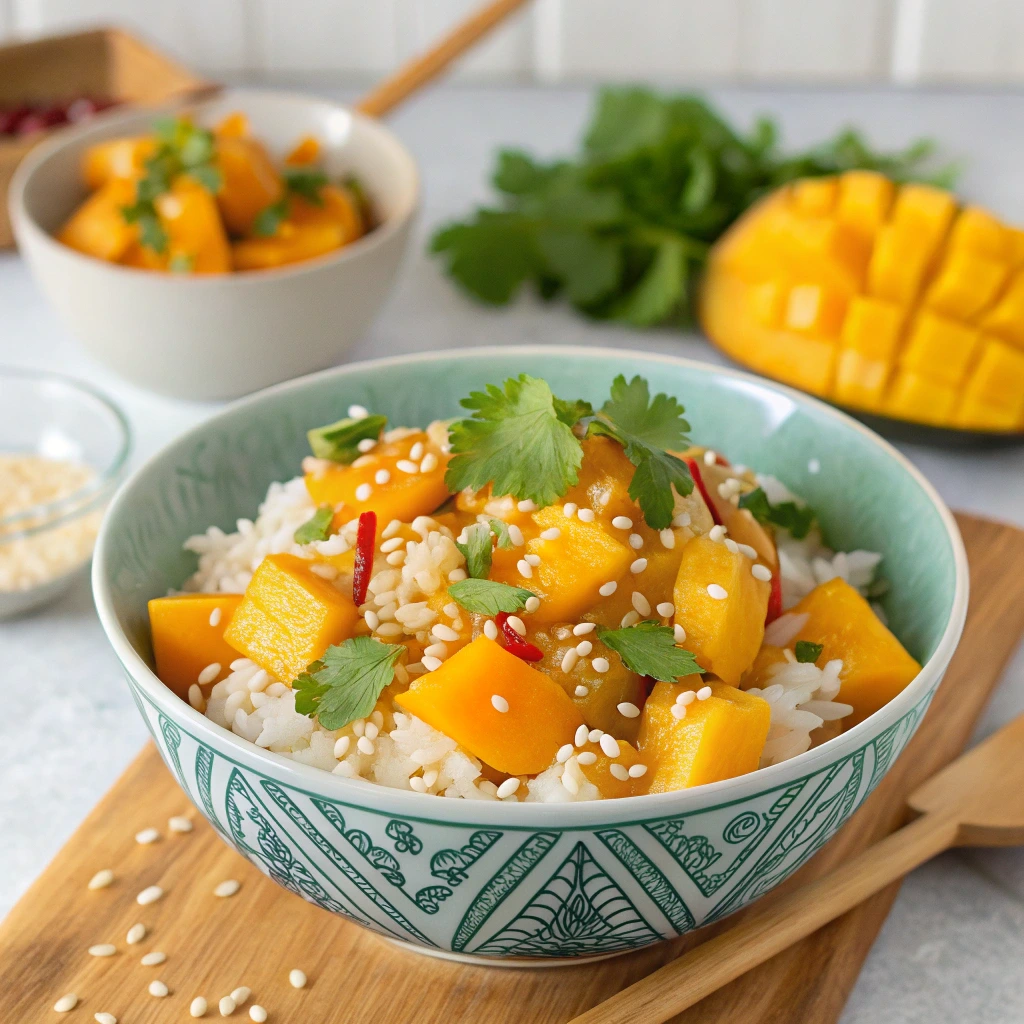
Creamy “Cheater’s” Mushroom Risotto: A Gourmet Rice Hack Recipe
Turn your leftover rice into a rich, velvety risotto—without the fuss! This “cheater’s” version uses pre-cooked rice, cutting the cooking time drastically while delivering all the comfort and creaminess of a traditional risotto. It’s a smart and satisfying way to transform leftover rice into a gourmet meal.
Ingredients You’ll Need:
- 2 cups cooked rice (short-grain or jasmine preferred)
- 1 tablespoon butter or olive oil
- 1 garlic clove, minced
- ½ small onion, finely chopped
- 1 cup mushrooms (button or cremini), sliced
- ½ cup vegetable or chicken broth
- ¼ cup heavy cream or milk
- ¼ cup grated Parmesan cheese
- Salt and pepper to taste
- Fresh parsley for garnish
Quick Cooking Method:
- Sauté aromatics and mushrooms: In a pan, melt butter and sauté the onion until translucent. Add garlic and mushrooms, cooking until the mushrooms are golden and tender.
- Add rice and liquids: Stir in the leftover rice, mixing well to coat it with the mushroom mixture. Pour in the broth and let it simmer for a few minutes to soften the rice and blend the flavors.
- Make it creamy: Add the cream and stir continuously until everything thickens. Fold in the Parmesan cheese and season with salt and pepper.
- Garnish and serve: Top with fresh parsley and a bit of extra cheese for a restaurant-style finish.
Why This Hack Works:
Traditional risotto requires constant stirring and slowly added liquid. But by using leftover rice, you skip straight to the good part—the creamy texture and deep umami flavor. It’s a time-saving technique perfect for weeknights or when you want a comforting dish with minimal effort.
Thai-Inspired Pineapple Fried Rice: A Flavor-Packed Rice Hack
Looking for a bold and refreshing way to transform leftover rice? This Thai-inspired pineapple fried rice hits the mark with its sweet, savory, and slightly spicy flavor. It’s vibrant, colorful, and perfect as a main course or a side dish.
Ingredients You’ll Need:
- 2 cups cold leftover rice (jasmine or basmati works best)
- 1 tablespoon oil (vegetable, sesame, or coconut)
- 2 garlic cloves, minced
- ¼ onion, diced
- ½ cup diced bell peppers (red or yellow)
- ½ cup pineapple chunks (fresh or canned, drained)
- ¼ cup shredded carrots
- 2 tablespoons soy sauce or tamari
- 1 teaspoon curry powder
- Optional: chili flakes or Sriracha for heat
- Fresh cilantro, lime wedges, and chopped cashews for garnish
How to Cook It:
- Sauté vegetables and aromatics: Heat the oil in a large pan or wok. Add garlic and onion, and cook until fragrant. Stir in bell peppers and carrots, cooking for 2–3 minutes.
- Add rice and seasonings: Add the leftover rice to the pan, breaking up any clumps with your spatula. Sprinkle in curry powder and soy sauce, stirring to coat everything evenly.
- Mix in pineapple: Gently fold in the pineapple chunks and cook for another 2–3 minutes until the rice is slightly crispy and everything is heated through.
- Finish with garnish: Remove from heat and top with fresh cilantro, chopped cashews, and a squeeze of lime for that signature Thai flair.
Why You’ll Love It:
This dish balances sweet and savory flavors beautifully. The juicy pineapple brightens the fried rice, while curry powder adds warmth and depth. It’s a fantastic way to use up leftover rice and reduce food waste while making a dish that feels restaurant-worthy
Rice-Stuffed Bell Peppers with Italian Herbs: A Creative Rice Recipe Hack
Turn your leftover rice into a cozy, satisfying dish by using it to fill vibrant bell peppers. This recipe combines hearty vegetables, rich tomato flavor, and classic Italian herbs—perfect for a weeknight dinner that feels like comfort food with a healthy twist.
Ingredients You’ll Need:
- 4 large bell peppers (any color), tops sliced off and seeds removed
- 2 cups cooked rice (brown, white, or jasmine rice work well)
- 1 cup cooked lentils or black beans (optional for protein boost)
- 1 cup marinara or tomato sauce
- ½ cup shredded mozzarella or plant-based cheese
- 1 small onion, finely chopped
- 2 garlic cloves, minced
- 1 teaspoon dried oregano
- 1 teaspoon dried basil
- ½ teaspoon crushed red pepper flakes (optional)
- Salt and pepper to taste
- Olive oil for sautéing
Step-by-Step Instructions:
1. Prep the Peppers:
Preheat the oven to 375°F (190°C). Carefully hollow out the bell peppers and lightly coat them with olive oil. Set aside.
2. Cook the Filling:
Heat olive oil in a skillet over medium heat. Sauté onions and garlic until fragrant. Stir in the rice, beans or lentils (if using), marinara sauce, and herbs. Let the mixture cook for 5–7 minutes, stirring occasionally. Add salt, pepper, and chili flakes to taste.
3. Stuff and Bake:
Spoon the rice mixture into each pepper, packing it gently. Top with shredded cheese. Place stuffed peppers upright in a baking dish. Cover with foil and bake for 25 minutes. Remove foil and bake uncovered for another 10 minutes until the cheese is bubbly and golden.
Why This Works:
These rice-stuffed bell peppers offer a beautiful blend of textures and Italian flavors. Using leftover rice reduces waste and saves time, making this dish ideal for meal prep. It’s customizable, too—swap in quinoa or add ground turkey or tofu if you like.
Sweet and Surprising Rice-Based Desserts from Simple Rice Hacks
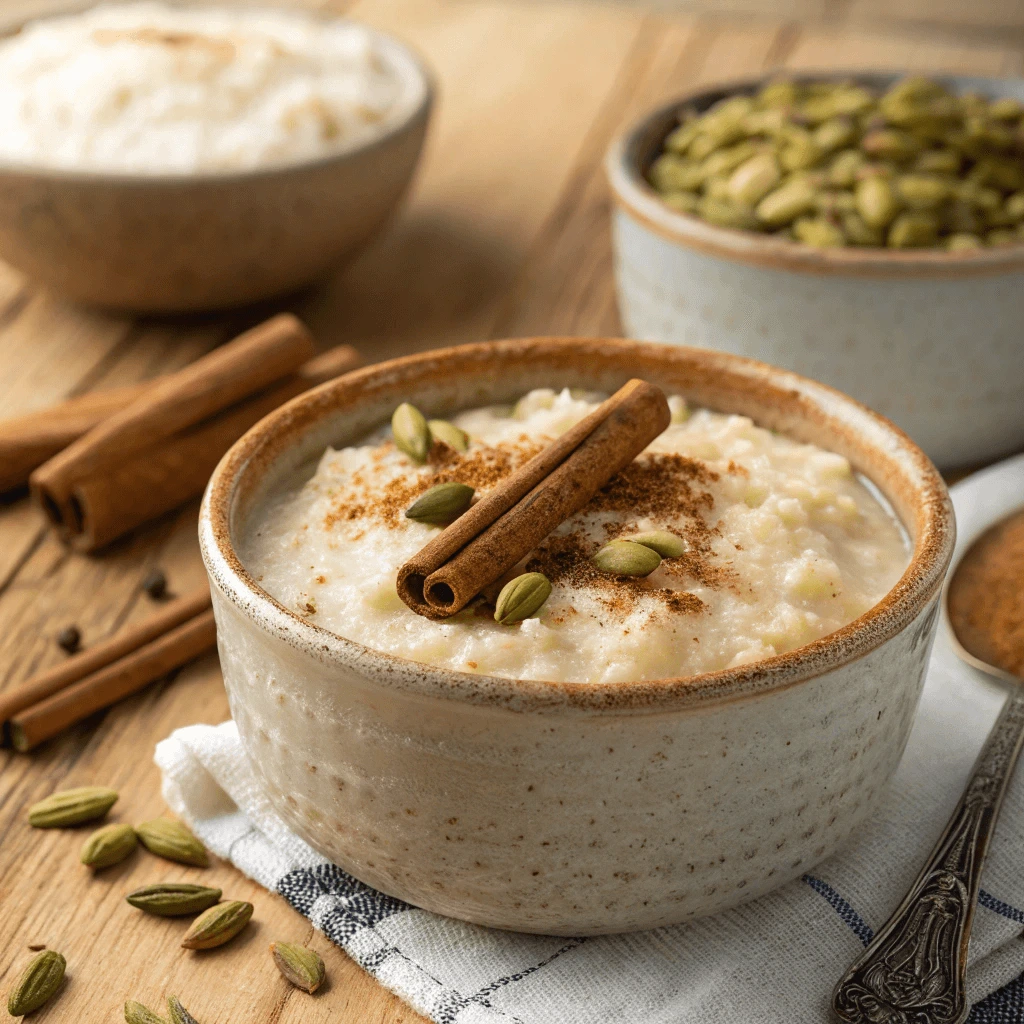
Classic Cardamom Rice Pudding: A Simple Rice Hack for Dessert
Give your leftover rice a luxurious second life with this creamy, aromatic dessert. Infused with warm spices and lightly sweetened, this classic cardamom rice pudding turns humble ingredients into a dish that feels indulgent yet comforting.
Ingredients You’ll Need:
- 2 cups cooked rice (preferably white or jasmine)
- 2½ cups milk (dairy or plant-based like almond or coconut)
- ¼ cup sugar (or substitute with maple syrup or honey)
- ½ teaspoon ground cardamom
- ¼ teaspoon cinnamon (optional)
- 1 teaspoon vanilla extract
- Pinch of salt
- Chopped pistachios or almonds for garnish (optional)
- Raisins or dried cranberries (optional for texture)
How to Make It:
1. Simmer the Base:
In a medium saucepan, combine the cooked rice and milk. Bring it to a gentle simmer over medium heat. Stir often to prevent the milk from scorching at the bottom.
2. Add Flavor and Sweetness:
Once the mixture begins to thicken (after about 10 minutes), stir in the sugar, cardamom, vanilla, cinnamon, and a pinch of salt. Lower the heat and continue simmering, stirring frequently, until it reaches your desired consistency—typically 10–15 more minutes.
3. Finish and Serve:
If you like a chunkier pudding, leave it as is. For a smoother texture, mash the rice slightly with the back of a spoon. Once done, spoon it into serving bowls and top with nuts, dried fruit, or even a drizzle of honey.
Why It Works:
This rice pudding recipe not only transforms leftover rice into a new dish but also celebrates it. The cardamom adds a floral depth that elevates the flavors, while the creamy texture offers a soothing, nostalgic feel. It’s easy to prepare, budget-friendly, and makes a satisfying dessert or cozy breakfast.
Chocolate Coconut Rice Bites: A No-Bake Rice Hack Dessert
Transform leftover rice into a delicious treat with these easy chocolate coconut rice bites. Combining rich cocoa, shredded coconut, and honey, these bites make for a satisfying dessert or snack. They are quick to prepare and perfect for satisfying your sweet tooth without hours of prep.
Ingredients:
- 1 cup cooked rice
- ½ cup shredded coconut (unsweetened)
- ¼ cup cocoa powder
- 2 tbsp honey or maple syrup
- 1 tbsp coconut oil
- 1 tsp vanilla extract
- Pinch of salt
Instructions:
- Mix: Combine rice, shredded coconut, cocoa powder, honey, coconut oil, and vanilla in a bowl. Stir until fully combined.
- Shape: Roll the mixture into bite-sized balls.
- Chill: Refrigerate for at least 30 minutes until firm. Serve and enjoy!
Why This Works:
These rice bites are a great way to use leftover rice, with coconut adding a chewy texture and cocoa giving them a rich, chocolatey flavor. Customize by adding chopped nuts or dried fruits!
Cinnamon Apple Rice Bake: A Wholesome Rice Dessert Hack
Transform leftover rice into a comforting dessert with this Cinnamon Apple Rice Bake. It combines sweet apples, cinnamon, and rice for a quick, satisfying treat.
Ingredients:
- 2 cups cooked rice (leftover)
- 2 apples, chopped
- ½ cup brown sugar
- 1 tsp cinnamon
- 1/2 tsp nutmeg
- 2 eggs
- 1 cup milk (dairy or non-dairy)
- 1 tsp vanilla extract
- Optional: ¼ cup raisins, 1 tbsp butter
Instructions:
- Preheat oven to 350°F (175°C) and grease a baking dish.
- Toss apples with sugar, cinnamon, and nutmeg. Set aside.
- In a separate bowl, whisk eggs, milk, and vanilla. Add rice and stir.
- Fold in the apples, pour into the dish, and dot with butter.
- Bake for 35-40 minutes until golden. Serve warm.
Tips:
Vegan Option: Use plant-based milk and flax eggs.
Customizable: Adjust sweetness or add nuts like walnuts for crunch.
Pro Tips to Elevate Your Rice Hacks and Recipes
How to Properly Store and Reheat Cooked Rice: A Rice Hack for Longevity
Storing and reheating leftover rice correctly is essential to maintain its taste and texture. Here are some tips to ensure your rice stays fresh and ready for your next meal.
Storing Leftover Rice
To store rice properly, it should cool quickly to avoid bacterial growth.
- Cool the Rice Fast: Spread rice on a baking sheet or place it in a shallow container to cool quickly.
- Use Airtight Containers: Store cooled rice in an airtight container to preserve moisture and flavor.
- Label and Date: If you plan to keep the rice for a few days, mark the date on the container. Aim to use it within 3-4 days.
Reheating Leftover Rice
When reheating rice, keep it moist and warm.
- Microwave: Add a tablespoon of water per cup of rice and cover it with a damp paper towel. Heat for 1-2 minutes, stirring halfway.
- Stovetop: Heat rice with a little water or broth in a saucepan, stirring occasionally until hot.
- Oven: Preheat to 300°F (150°C), cover rice with foil, and heat for 15-20 minutes.
By following these steps, your leftover rice will stay fresh, moist, and ready for your next meal!
Flavor-Boosting Add-ins to Always Keep on Hand: Essential Rice Recipe Hacks
Leftover rice doesn’t have to be boring. With the right flavor-boosting ingredients, you can easily elevate your rice into something exciting. Here are some key add-ins that can transform your rice dishes with minimal effort.
Essential Herbs and Spices
Herbs and spices can completely change the flavor of your rice, making it more aromatic and flavorful. Some essentials include:
- Garlic Powder: Adds a savory kick when mixed with butter or oil.
- Cumin: Perfect for warm, earthy flavors, especially in Mexican or Indian-inspired dishes.
- Turmeric: Provides a vibrant color and a mild, fragrant taste.
- Cilantro: For a fresh, citrusy punch, perfect in many rice bowls.
Flavorful Sauces to Try
Sauces are another great way to infuse rice with rich, bold flavors. Consider these options:
- Soy Sauce: Adds depth and a savory umami quality.
- Hot Sauce: Gives your rice a spicy kick, with various varieties for different heat levels.
- Fish Sauce: A little goes a long way in giving your rice a unique umami flavor.
Protein Add-ins for a Complete Meal
Adding protein makes your rice more filling and well-rounded. Some easy protein options include:
- Eggs: Scrambled or fried, they bring richness to rice dishes like fried rice.
- Chicken: Shredded rotisserie chicken is quick and adds heartiness.
- Tofu: Ideal for vegetarians, tofu absorbs flavors and adds protein without overpowering the dish.
These add-ins are simple to keep on hand and can instantly upgrade your leftover rice into a flavorful meal.
Turn Rice into One-Pot Meals and Casseroles: Easy Rice Hack Meals
Leftover rice can be easily turned into a one-pot meal or casserole, creating a quick and flavorful dish that’s filling and satisfying. These recipes help minimize prep time, reduce dishes, and allow you to get creative with the ingredients you have on hand.
Why One-Pot Meals Are a Game Changer
One-pot meals are perfect for those busy days when you need to whip up something delicious with minimal effort. Cooking everything in one pot reduces cleanup and allows the rice to absorb all the delicious flavors from the other ingredients. It’s also a great way to use up leftovers, reducing food waste.
Tasty One-Pot Rice Casserole Ideas
A casserole is a simple way to turn leftover rice into a comfort food classic. You can mix rice with proteins, veggies, and seasonings, then bake it all together in the same dish. Popular options include chicken and rice casseroles, vegetable-filled dishes, or cheesy Mexican rice bakes. These meals are easy to prepare and can feed a crowd.
Quick One-Pot Rice Meals
For a quicker alternative to casseroles, try a one-pot skillet meal. You can stir-fry leftover rice with various proteins (like beef, shrimp, or chicken) and veggies for a flavorful and balanced meal. A simple beef and rice skillet or shrimp fried rice are perfect examples of how to turn leftover rice into something amazing in just minutes.
With these ideas, you can transform leftover rice into satisfying, delicious meals with minimal effort.
Meal Prep Ideas with Rice That Save Time and Money Using Simple Rice Hacks
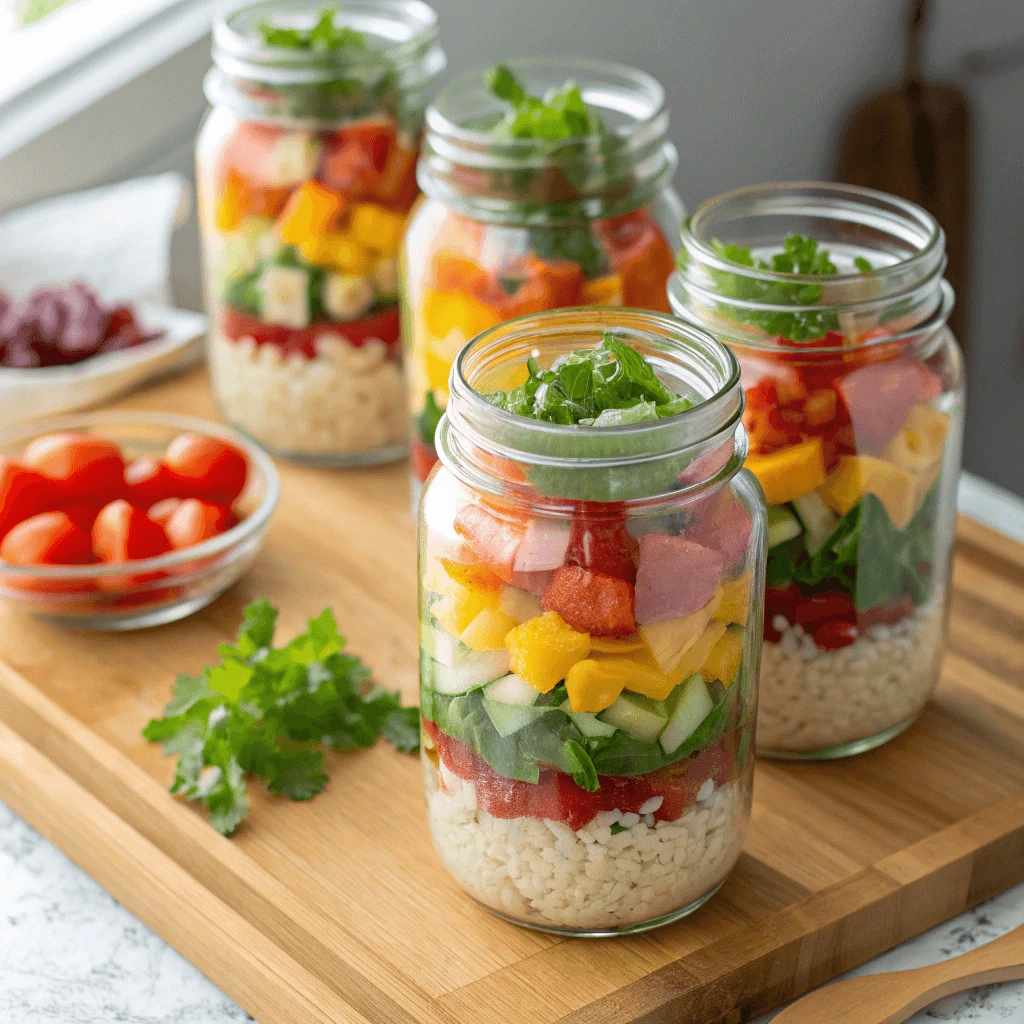
Mason Jar Rice Salads for Work Lunches: Easy Rice Meal Prep Hacks
Mason jar salads are a convenient and healthy lunch option, and when combined with leftover rice, they become even more satisfying. These salads are easy to assemble, store, and transport, making them perfect for meal prepping and work lunches.
Benefits of Mason Jar Rice Salads
Mason jar salads offer the benefit of being portable and easy to prepare in advance. You can prepare several jars at once and store them in the fridge for a quick, nutritious meal throughout the week. The rice in these salads absorbs the dressing, making each bite flavorful and hearty.
How to Layer Mason Jar Rice Salads
Start by adding your dressing to the bottom of the jar to prevent the rice from getting soggy. Follow with the leftover rice and then layer in your veggies and proteins, finishing with leafy greens on top. This method ensures that the salad stays fresh until you’re ready to eat.
Rice Salad Variations
You can customize your mason jar rice salad with different ingredients like grilled chicken, beans, or roasted vegetables. Try a Mediterranean-style salad with olives, feta, and tomatoes, or an Asian-inspired one with edamame, carrots, and sesame dressing. Experiment with different flavors to suit your taste.
These rice salads are a great way to repurpose leftover rice into a delicious and filling lunch.
Rice and Bean Meal Prep Bowls: A Budget-Friendly Rice Hack for Meal Prep
Rice and bean meal prep bowls are a nutritious, filling, and budget-friendly way to enjoy leftover rice. These bowls are incredibly versatile and can be customized to suit your tastes or dietary preferences. Plus, they are an excellent option for meal prepping since they store well in the fridge and can be easily reheated for a quick, wholesome meal throughout the week.
Benefits of Rice and Bean Bowls
Rice and beans make the perfect meal base. They are rich in fiber, protein, and essential nutrients, making them a balanced choice for anyone looking for a healthy meal. Combining rice with beans not only provides a satisfying texture but also ensures you’re getting a well-rounded dish, perfect for refueling during a busy week.
How to Assemble Rice and Bean Meal Prep Bowls
Start by cooking a batch of your favorite rice—white, brown, or even wild rice works well in these bowls. Then, choose your beans—black beans, kidney beans, or chickpeas are all great options. Add a protein source like grilled chicken, tofu, or seasoned ground meat. Layer the rice, beans, protein, and some veggies in containers. Don’t forget to add some healthy fats like avocado or a drizzle of olive oil. Top with fresh herbs or a squeeze of lime for extra flavor.
Flavor Boosters for Rice and Bean Bowls
To elevate your rice and bean bowls, consider adding a few flavor boosters. Salsa, sour cream, or guacamole can all add freshness and creaminess. For a spicier kick, try adding hot sauce or diced jalapeños. A sprinkle of cheese, such as cheddar, feta, or a vegan alternative, can also bring richness to the dish.
These rice and bean meal prep bowls are not only simple to make but also incredibly versatile. You can change up the ingredients each week to keep your lunches exciting. They are a great way to transform leftover rice into something delicious, filling, and nutritious!
Freezer-Friendly Rice and Veggie Stir-Fry Packs: A Time-Saving Rice Hack
Freezer-friendly rice and veggie stir-fry packs are a great way to save time and ensure quick, healthy meals. You can prepare these packs in advance and store them in the freezer, ready for busy days when you need a fast, nutritious meal.
Why Freezer-Friendly Stir-Fry Packs Work
These stir-fry packs are perfect for meal prep, allowing you to use up leftover rice and vegetables. They help you reduce food waste while making meal times easier. Plus, you can switch up the ingredients based on what you have on hand, making them versatile and cost-effective.
Making Freezer-Friendly Stir-Fry Packs
To make the packs, cook rice and let it cool. Chop your veggies (like peppers, peas, or carrots) and protein (tofu, chicken, or shrimp). Portion them into freezer-safe containers or bags, adding a stir-fry sauce or marinade (soy sauce, sesame oil, and honey work well).
Cooking the Stir-Fry
When you’re ready to eat, simply thaw the pack overnight or cook it straight from the freezer. Stir-fry in a pan with some oil for 5 to 10 minutes, and enjoy a flavorful, homemade meal in no time.
Conclusion
Transforming leftover rice into exciting dishes is quick, easy, and budget-friendly. With a little creativity, you can turn simple rice into flavorful meals, whether it’s fried rice, casseroles, or even desserts. The possibilities are endless, so don’t hesitate to experiment with your own favorite ingredients. Ready to give it a try? Share your favorite rice hack or let us know how you used leftover rice in the comments below!
